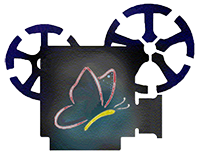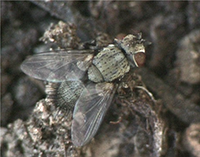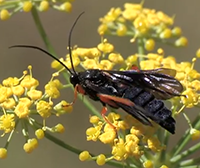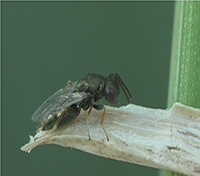

The parasitoid Buquetia musca (Robineau-Desvoidy, 1847) is specialized in parasitizing only the caterpillars of Papilio machaon.
Identified by Dr. Hans-Peter Tschorsnig

![]() Biological observations on Buquetia musca (Robineau-Desvoidy) (Diptera: Tachinidae), a parasitoid of Papilio machaon Linné (Lepidoptera: Papilionidae)
Biological observations on Buquetia musca (Robineau-Desvoidy) (Diptera: Tachinidae), a parasitoid of Papilio machaon Linné (Lepidoptera: Papilionidae)
2015 - Pieter Kan & Brigitte Kan-van Limburg Stirum
Filming VarWild (March, 2015)
Abstract
Buquetia musca is a tachinid that parasitizes the caterpillars of Papilio machaon. Oviposition behaviour of this parasitoid has been studied and, for the first time, deposition of eggs on the skin of the caterpillar has been observed and filmed. Subsequently, the development of parasitized caterpillars has been followed and recorded.
The parasitoid Trogus lapidator (Fabricius, 1787) is a specialist who only parasitizes the caterpillars of the genus Papilio (P. machaon and P. alexanor). After parasitizing the caterpillar with one single egg the larva develops inside the body. Once the caterpillar has become a chrysalis the parasitoid wasp emerges from a lateral hole in the wing case.
Identified by Dr. Mark R. Shaw

![]() Emergence behaviour of adult Trogus lapidator (Fabricius)(Hymenoptera, Ichneumonidae, Ichneumoninae, Heresiarchini) from pupa of its host Papilio machaon L.
(Lepidoptera, Papilionidae), with a comparative overview of emergence of Ichneumonidae from Lepidoptera pupae in Europe
Emergence behaviour of adult Trogus lapidator (Fabricius)(Hymenoptera, Ichneumonidae, Ichneumoninae, Heresiarchini) from pupa of its host Papilio machaon L.
(Lepidoptera, Papilionidae), with a comparative overview of emergence of Ichneumonidae from Lepidoptera pupae in Europe
2015 - Mark R. Shaw, Pieter Kan & Brigitte Kan-van Limburg Stirum,
JHR 47: 65–85
Abstract
Unusually for Ichneumonidae, Trogus lapidator emerges through a hole in the pupal wing case of its papilionid butterfly host that is made largely by a liquid secretion that softens and disintegrates the host tissue. The mandibles are deployed to help spread the secretion, but only towards the very end of the emergence process are they used (and then only in a minor way) to enlarge the hole. Links to video clips showing the emergence of T. lapidator are provided. Photographs illustrating the nature of emergence holes left in Lepidoptera pupae by a range of Ichneumonidae and some Chalcidoidea are presented and discussed, contrasting with the emergence hole left by Trogus and close allies.
Pteromalus puparum (Linné, 1758) is a generalist of 2mm, parasitizing especially the chrysalis of different species of butterflies from the families Papilionidae, Pieridae et Nymphalidae.
Identified by Dr. Richard Askew